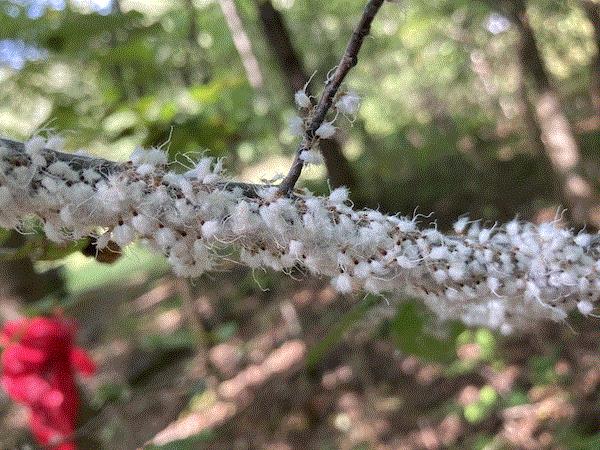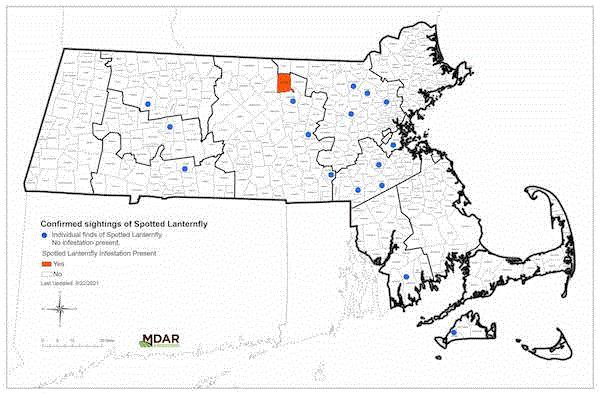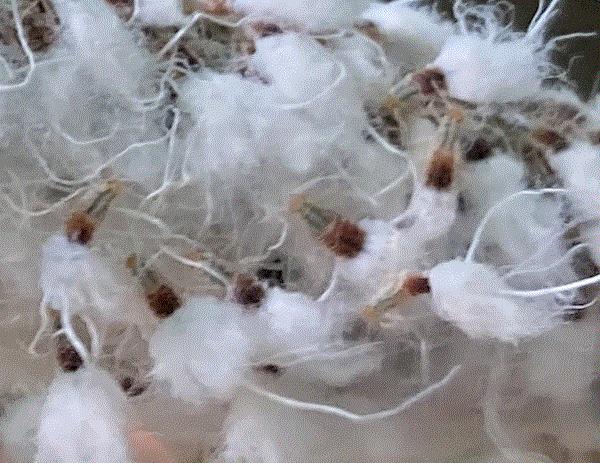What the ... ?
Something is going on in Elaine Kavanagh’s woods. She found these white fuzzes on a beech branch.
What do y’all think those are?
Before we get to the answer, I want to circle back to something I mentioned in the last issue.

Photo credit: Elaine Kavanagh.
Earwigs follow-up
Several of you shared with me your experience and jokes about earwigs last week. Thank you! I don't know if there is something about the computer chips in those loggers or not, but they liked the logger as a home.
Nicole Sanchez of Oregon State University shared a perspective different from mine. Nicole would have agreed with me that earwigs may not be a big deal in the South, but they can be a menace and extremely devastating in the high desert of Oregon. Damage is particularly severe early in the season. Nicole shared a picture of what earwigs did to her viburnum.

Photo credit: Nicole Sanchez, Oregon State University
Now that we established the fact that earwigs can feed on plants, especially when foliage, flower buds and stems are tender, the next question is: what we can do about it?
There are countless suggestions or recommendations on the web. Recommendations generally fall under the categories of removing shelter, trapping and insecticide application. Shelter removal includes removing mulch or debris that isn’t necessary to making a landscape beautiful but can provide shelter to the earwigs. I think that recommendation is sensible not just as a recommendation for earwigs but for other critters that may come into the house, such as roly-polies, ants and palmetto bugs.
There are all kinds of traps but generally the most effective are traps that provide shelters (so you can kill those earwigs that hide in there) or baited traps. The shelter traps can be anything from rolled up newspaper to pieces of wood—anything that can give the earwigs a place to hide and a sense of false security during the day. The baited traps are generally pitfall traps, which are made of some sort of containers buried in the ground with the lids of the containers flush with ground surface. The earwigs dropped into the trap and can’t come back up. These traps are usually baited with strong smelling oils, such as fish oil and animal fat. Some even call for a mixture of soy sauce and vegetable oil. I think oil would do just fine by itself. Keep the traps away from animals; I know my wife’s dog would love to have some of those fats; “I smell bacon!”
Then, there are insecticides. I dug up a study by Whitney Cranshaw of Colorado State University and his graduate student, Colvin Bennett, published in Southwestern Entomologist (volume 35, page 69 to 74) in 2010. Whitney and Colvin evaluated the efficacy of some products available for homeowner uses and found that the pyrethroids (bifenthrin, deltamethrin and permethrin) did quite well in killing the European earwigs and preventing damage to surfaces. I think repeated applications might be needed for protection over a long period of time because pyrethroids break down relatively quickly under the sun.
I feel like I need to see for myself what earwigs can do in Oregon. Some nice wine and beer along the way are just icing on the cake! I think I heard my wife packing her luggage.

IR-4 sets research priorities for the next two years
I attended the IR-4 Environmental Horticulture Program’s Priority Setting Meeting last week. During this meeting, researchers, growers and representatives of pesticide manufacturers and distributors identified research priorities for 2022 and 2023. The decision to put research dollars on a specific pest problem was based largely on a survey of growers and extension personnel, and discussion among the meeting attendees.
So, what are the major pest problems?
According to the survey, which had 99 responses with the majority from the Western Region (42%), the top five insect and mite pest groups are (in the descending order of importance) mites and spider mites, scale insects and mealybugs, thrips, aphids, and borers and beetles. The top five disease groups are crown and root rots, phytophthora and pythium, leaf spots and anthracnose, bacterial diseases, and powdery mildew. The top five weeds are summer annual broadleaves, liverworts/moss/algae, grass, perennial broadleaves, and sedge and nutsedge. The identified “tops” aren't that different from the 2018/2019 survey. Are these also your biggest problems?
After discussions in several breakout meetings over three days, the attendees agreed on a list of national research priorities.
Plant pathology national priorities: phytophthora and pythium efficacy; non-oomycete root and crown rot efficacy.
Entomology national priorities: borer and beetle efficacy; mealybug and scale insect efficacy.
Both plant pathology and entomology also include crop safety of new products as national priorities.
Weed science national priorities: preemergent herbicide crop safety, postemergent herbicide efficacy, and nostoc efficacy on hard surfaces.
In addition to the national priorities, the group also identified several regional priorities:
Southern regional priorities: bacterial leaf spot efficacy; eriophyid mite efficacy.
North-central regional priorities: botrytis efficacy; botryosphaeria canker efficacy.
Northeastern regional priorities: fatty acid herbicide efficacy; botrytis efficacy.
Western regional priorities: preemergent herbicide crop safety for field production of bulbs, cut flowers and ornamental grasses; thrips efficacy.
The next step is to work with manufacturers and see what new products we can test for the identified pests, and develop the trial protocols.

Spotted lanternfly found in Massachusetts
What’s feared has finally happened. The Massachusetts Department of Agricultural Resources (MDAR) announced on September 29th that a small, established population of spotted lanternfly has been found in Fitchburg, in central Massachusetts. (By the way, do y’all have as much trouble spelling Massachusetts as I do? It took me two tries before I got it right in the previous sentence.)
By “small” MDAR meant three trees in a cluster. Now, you may be wondering why the big fuss over bugs on three trees. The most critical piece of this news is the fact that the population is now there albeit a small population on three trees. Inspectors and regulators in Massachusetts are doubling down on their surveying efforts, and urging folks to report any suspected sightings of the critter.

Map sourced from Massachusetts Department of Agricultural Resources (MDAR).
It’s not clear at this point where the spotted lanternflies came from. A nymph was found nearby earlier this summer, but it’s not clear how widespread the population may be. Also unknown is whether quarantine or other regulatory actions may be imposed in the area. I suppose more information is forthcoming.
For more information about the spotted lanternfly in Massachusetts, click here. Check out the distribution of spotted lanternfly (up to September 14th) by clicking here.

GrowerTalks Wage and Benefit Survey
It’s time for the annual GrowerTalks and Green Profit Wage and Benefit Surveys, sponsored by Florasearch. If you are new to this game, these are actually two surveys. If you are a grower, please click here to complete the grower survey. If you are a retailer, please click here to complete the retailer survey.
Don't worry! These are not one of those never-ending surveys. I did one of them in about five minutes; I’m sure you could, too. If you give an address at the end of the survey and if you are the lucky winner, the nice people at GrowerTalks or Green Profit (one winner will be selected for each survey) will send you a YETI Tundra 45 Hard Cooler.

Click here for a summary of the 2020 survey results. Labor was still an issue, but COVID was really making things more complicated. It’s fascinating how varied folks’ responses were to the question of how they planned to adjust their staffing because of COVID pandemic.
Answer to "What the ... ?"
At first I thought, “Man, this is easy! These white fuzzes are the nymphs of some planthoppers. I have seen these critters many a time.” Then I read Elaine’s email again, and I thought, “Beech branches. Hmm … I need to look into that.”
Well, I’m glad I did. Otherwise I would have embarrassed myself, even though it wouldn’t have been the first time. My first impression was wrong. These white fuzzes turned out to be beech blight aphids.

Photo credit: Elaine Kavanagh.
These are aphids, not their cousins the planthoppers. Beech blight aphid is first cousin to the hackberry woolly aphid. Similar to woolly aphids and planthopper nymphs, the beech blight aphids also can produce a lot of wax filaments at their rear ends. They feed on American beech, and can build up to a spectacularly huge population. The infested branches seem covered with “blight.”
The aphids “dance” or wiggle when they are disturbed or feel threatened. The aphids raise their fuzzy rear ends and wave. It’s not just one or two, but the whole group wiggles at the same time. Because of this, they are sometimes called the boogie-woogie aphids.
The aphids aren't just the dancing queens. If you push them hard enough, they’ll fight back! A study found that fourth-instar nymphs could actually attack their predators using their stylets or the piercing-sucking mouthparts. Not to suck out a predator’s blood, but at least to cause enough discomfort that the predators regret messing with them.
Fun bunch of aphids. Thanks for sharing, Elaine!




See y'all later!

JC Chong
Professor of Entomology at Clemson University
This e-mail received by 26,766 subscribers like you!
If you're interested in advertising on PestTalks contact Kim Brown ASAP!